Jozef Murgaš facts for kids
Jozef Murgaš (also known as Joseph Murgas in English) was a fascinating Slovak man born on February 17, 1864, who passed away on May 11, 1929. He was many things: an inventor, an architect, a botanist (someone who studies plants), a painter, and even a Roman Catholic priest. He made important contributions to the early development of radio, which people back then often called "wireless telegraphy".
Because of his work with radio, Murgaš was sometimes called the Radio Priest. People also thought of him as a "Renaissance man" because he was skilled in so many different areas.
Contents
Life Story of Jozef Murgaš
Early Life in Europe
Jozef Murgaš was born in a place called Tajov in what was then the Kingdom of Hungary (now part of Slovakia). From a young age, he was very clever and good at many things, especially painting and anything to do with electricity.
He studied to become a priest in several cities, including Bratislava and Banská Bystrica, finishing his studies in 1888. While he was studying, his teachers noticed his talent for painting. One teacher even let him use the physics lab for his experiments!
After becoming a priest in 1888, Murgaš worked in different churches. He also continued to study painting in Budapest and Munich for several years. He painted religious pictures, beautiful Slovak landscapes, and portraits of important Slovak people.
However, because he was very patriotic and proud of his Slovak heritage, he faced some difficulties. He wasn't allowed to finish his painting studies and had to move to different church jobs in the Kingdom of Hungary. During this time, he painted a large picture of St. George for a church in Lopej, which is still there today. He also painted the main altar picture of St. Elisabeth in a 14th-century church in Banská Bystrica.
Moving to the United States
In 1896, Jozef Murgaš had to move to the United States because of disagreements with a church official. He was assigned to a Slovak church in Wilkes-Barre, Pennsylvania. Since he couldn't paint as much there, he started focusing again on science, especially electricity and radio.
He set up a laboratory in Wilkes-Barre to study radiotelegraphy. By 1900, his research was quite advanced. In 1904, he received his first two US patents for his "Apparatus for wireless telegraphy" and "The way of transmitted messages by wireless telegraphy". A patent is like an official document that protects an inventor's new idea.
After these first two patents, he received 15 more between 1907 and 1916. Based on his first two inventions, he started a company called Universal Aether Telegraph Co. In September 1905, they showed off Murgaš's radio equipment in a public test, and it worked well! Sadly, a big storm destroyed the antenna towers three months later, and the company had to close down.
Helping Slovak Immigrants
Even with his inventions, Murgaš's main focus in Wilkes-Barre was helping the local Slovak people. He took care of Slovak immigrants, making sure they had what they needed. He helped build a new church, a library, a cemetery, several schools, a gym, and playgrounds. Many of these are still used by American Slovaks today.
He also helped start the Saints Cyril and Methodius community and cared for children and young people. He was very popular because he truly connected with the people he served. He even published a newspaper where he wrote science articles and poems.
Murgaš was also very active in the Slovak community living abroad. He wrote articles for their newspapers and helped found the Slovak League in America. He strongly supported the idea of creating the country of Czechoslovakia. He helped raise a lot of money (US$1,000,000) from American Slovaks for this cause. He was also one of the people who signed the Pittsburgh Agreement in 1918, which was an important step in creating Czechoslovakia. Because he was so respected, he gained the trust of high-ranking officials in the US government to support this new country.
Later Life and Hobbies
Jozef Murgaš continued to study physics and do experiments. He often sold his paintings to pay for his scientific work. He also loved collecting things from nature, like mushrooms, plants, minerals, and insects. His butterfly collection was huge, with 9,000 butterflies from all over the world!
When the United States joined World War I, private radio stations were not allowed. This stopped Murgaš's pioneering work in radio for a while. After Czechoslovakia was created, he returned to Slovakia in 1920. He taught about electricity at a high school, but he didn't feel supported by the government there. So, he returned to Wilkes-Barre just four months later. Jozef Murgaš passed away in Wilkes-Barre in 1929.
Why Murgaš Was Important
In 1905, Murgaš successfully sent a radio message between Wilkes-Barre and Scranton, Pennsylvania, which was 20 miles (32 km) away. He used a special "tone system" for Morse code. Instead of just beeps, he used a higher-pitched tone for "dots" and a lower-pitched tone for "dashes." This was a new idea at the time.
Even famous inventor Thomas Edison was very interested in Murgaš's experiments. It's even said that Edison told Guglielmo Marconi, another radio pioneer, about Murgaš's success. In 1905, US President Theodore Roosevelt himself visited Murgaš's lab in Wilkes-Barre!
Jozef Murgaš's Patents (1904-1916)
Here are some of the important patents Jozef Murgaš received for his inventions:
- U.S. Patent 759,825 "Wireless-telegraph apparatus" (1904)
- U.S. Patent 759,826 "The way of transmitted messages by wireless telegraphy" (1904)
- U.S. Patent 860,051 "Constructing Antennas for Wireless Telegraphy" (July 16, 1907)
- U.S. Patent 848,675 "Wave meter" (1907)
- U.S. Patent 848,676 "Electrical transformer" (1907)
- U.S. Patent 860,051 "Underground wireless telegraphy"
- U.S. Patent 876,383 "Apparatus for making electromagnetic waves" (1908)
- U.S. Patent 915,993 "Wireless telegraphy" (1909)
- U.S. Patent 917,103 "Making of sparkles frequency from power supply without interrupter" (1909)
- U.S. Patent 917,104 "Magnetic waves detector" (1909)
- U.S. Patent 930,780 "Magnetic detector" (1909)
- U.S. Patent 1,001,975 "Apparatus for making electrical oscillations" (1911)
- U.S. Patent 1,024,739 "Spinning reel for fishing rod" (1912)
- U.S. Patent 1,196,696 Improved invention in the United States; also given in England GB9726 in 1907
- U.S. Patent 1,196,969 "The way and apparatus for making electrical alternating current oscillations" (1916)
- He was also a co-author on two inventions related to electrical arc lamps (1910).
Memorials and Honors for Jozef Murgaš
Many places and things honor Jozef Murgaš and his contributions:
- In Tajov, where he was born, you can visit his house, a special memorial room, and a symbolic grave at the local cemetery. This memorial room has original pictures, paintings, some unique pieces from his butterfly collection, models of his wireless telegraphy inventions, and important documents. You can also see a small model of the original antenna towers his company built in Wilkes-Barre in 1905.
- The Rev. Jozef Murgaš Room at King's College (Pennsylvania) is named after him.
- There is a Jozef Murgaš Monument in Bratislava, Slovakia, located near the Slovak Telecom building.
- A street in Podbrezová-Lopej, Slovakia, is named Jozef Murgaš street.
- There is a Joseph Murgas Monument in Wilkes-Barre, Pennsylvania.
- You can see his paintings in a church in Wilkes-Barre, Pennsylvania, and in the Memorial room in Tajov, as well as in some churches in Lopej and Banská Bystrica.
- The Murgas Amateur Radio Club in Wilkes-Barre, PA, was named after him in 1975.
- A model of Murgaš' transmitting station is displayed in Wilkes-Barre.
- His amazing collection of 9,000 butterflies from around the world is preserved.
- A Liberty ship called the SS Joseph Murgas was launched in the US state of Georgia in 1944.
- The Jozef Murgaš Secondary School of Electrical Engineering in Banská Bystrica, Slovakia, is named after him.
- The Jozef Murgaš Primary School in Šaľa, Slovakia, also carries his name.
- A special Jozef Murgaš stamp was issued by the Slovak Republic in 1994 to celebrate his 130th birthday.
- The Jozef Murgaš Award is given out every year by the Slovak Electrotechnical Society and the Ministry of Transport, Posts and Telecommunications of the Slovak Republic. This award honors new ideas and developments in telecommunications in Slovakia.
See also
- List of Roman Catholic scientist-clerics



